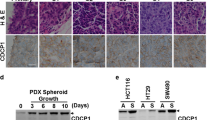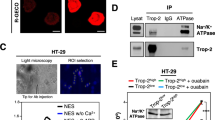Abstract
Deleted in colon cancer (DCC) and UNC5 function as netrin dependence receptors by inducing apoptosis in the absence of their ligand and accordingly were recently designated as putative conditional tumor suppressors. Herein, we determined whether netrin-1 and its receptors are implicated in cancer cell invasion and tumor progression. Expression of DCC, UNC5 and adenosine A2B-receptors (A2B-Rs) was investigated by reverse transcription polymerase chain reaction in human colon cancer cells. The impact of DCC restitution and netrin-1 was evaluated on collagen type I invasion, tumor growth and metastasis in nude mice, cancer cell survival and gene expression profiling. Flow cytometry, poly(ADP-ribose)polymerase-1 and caspase-8 activation were used to evaluate the impact of DCC on cell death. Both netrin-1 and A2B-R activation induced the invasive phenotype through the Rho–Rho kinase axis in DCC-deficient human colorectal cancer cells. Restitution of wild-type DCC blocked invasion induced by netrin-1, A2B-R agonist and other agents. Ectopic expression of netrin-1 led to increased growth of human colon tumor xenografts in athymic mice. Conversely, introduction of wt-DCC in kidney MDCKts.src-ggl cells strongly inhibited metastasis in lymph nodes and lungs and increased sensitivity to apoptosis in hypoxia. DNA microarrays revealed that netrin and DCC had common and divergent impacts on gene expression linked to cell cycle, survival, surface signaling and adhesion. Our findings underscore that netrin is a potent invasion and tumor growth-promoting agent and that DCC is a metastasis suppressor gene targeting both proinvasive and survival pathways in a cumulative manner.
This is a preview of subscription content, access via your institution
Access options
Subscribe to this journal
Receive 50 print issues and online access
$259.00 per year
only $5.18 per issue
Buy this article
- Purchase on Springer Link
- Instant access to full article PDF
Prices may be subject to local taxes which are calculated during checkout




Similar content being viewed by others
Abbreviations
- A2B-R:
-
adenosine A2B-receptor
- DCC:
-
deleted in colon cancer
- EGF-R:
-
epidermal growth factor receptor
- GCOS:
-
GeneChip Operating System v1.4
- GPCR:
-
G-protein-coupled receptors
- PARP:
-
poly(ADP-ribose)polymerase-1
- PI3K:
-
phosphatidylinositol 3-kinase
- PKA:
-
protein kinase A
- PLCβ:
-
phospholipase Cβ
- ROK:
-
Rho-kinase
- RT–PCR:
-
reverse transcription–polymerase chain reaction
- TGFα:
-
transforming growth factor α
- TFFs:
-
trefoil factors
References
Arakawa H . (2004). Netrin-1 and its receptors in tumorigenesis. Nat Rev Cancer 4: 978–987.
Barbier M, Attoub S, Calvez R, Laffargue M, Mareel M, Altruda F et al. (2001). Weakening link to colorectal cancer? Nature 413: 796.
Bouchard JF, Moore SW, Tritsch NX, Roux PP, Shekarabi M, Barker PA et al. (2004). Protein kinase A activation promotes plasma membrane insertion of DCC from an intracellular pool: a novel mechanism regulating commissural axon extension. J Neurosci 24: 3040–3050.
Chen L, Wang P, Andrade CF, Zhao IY, Dube PE, Brubaker PL et al. (2005). PKA independent and cell type specific activation of the expression of caudal homeobox gene Cdx-2 by cyclic AMP. FEBS J 272: 2746–2759.
Corset V, Nguyen-Ba-Charvet KT, Forcet C, Moyse E, Chedotal A, Mehlen P . (2000). Netrin-1-mediated axon outgrowth and cAMP production requires interaction with adenosine A2b receptor. Nature 407: 747–750.
Fearon ER, Cho KR, Nigro JM, Kern SE, Simons JW, Ruppert JM et al. (1990). Identification of a chromosome 18q gene that is altered in colorectal cancers. Science 247: 49–56.
Forcet C, Stein E, Pays L, Corset V, Llambi F, Tessier-Lavigne M et al. (2002). Netrin-1-mediated axon outgrowth requires deleted in colorectal cancer-dependent MAPK activation. Nature 417: 443–447.
Gao L, Feng Y, Bowers R, Becker-Hapak M, Gardner J, Council L et al. (2006). Ras-associated protein-1 regulates extracellular signal-regulated kinase activation and migration in melanoma cells: two processes important to melanoma tumorigenesis and metastasis. Cancer Res 66: 7880–7888.
Grider JR, Piland BE, Gulick MA, Qiao LY . (2006). Brain-derived neurotrophic factor augments peristalsis by augmenting 5-HT and calcitonin gene-related peptide release. Gastroenterology 130: 771–780.
Hebrok M, Reichardt LF . (2004). Brain meets pancreas: netrin, an axon guidance molecule, controls epithelial cell migration. Trends Cell Biol 14: 153–155.
Hill A, McFarlane S, Mulligan K, Gillespie K, Gillespie H, Draffin JE et al. (2006). Cortactin underpins CD44-promoted invasion and adhesion of breast cancer cells to bone marrow endothelial cells. Oncogene 25: 6079–6091.
Hipfner DR, Cohen SM . (2004). Connecting proliferation and apoptosis in development and disease. Nat Rev Mol Cell Biol 5: 805–815.
Hong K, Hinck L, Nishiyama M, Poo MM, Tessier-Lavigne M, Stein E . (1999). A ligand-gated association between cytoplasmic domains of UNC5 and DCC family receptors converts netrin-induced growth cone attraction to repulsion. Cell 97: 927–941.
Hu G, Zhang S, Vidal M, Baer JL, Xu T, Fearon ER . (1997). Mammalian homologs of seven in absentia regulate DCC via the ubiquitin-proteasome pathway. Genes Dev 11: 2701–2714.
Hucho TB, Dina OA, Levine JD . (2005). Epac mediates a cAMP-to-PKC signaling in inflammatory pain: an isolectin B4(+) neuron-specific mechanism. J Neurosci 25: 6119–6126.
Kadono Y, Okada Y, Namiki M, Seiki M, Sato H . (1998). Transformation of epithelial Madin-Darby canine kidney cells with p60(v-src) induces expression of membrane-type 1 matrix metalloproteinase and invasiveness. Cancer Res 58: 2240–2244.
Kim TH, Lee HK, Seo IA, Bae HR, Suh DJ, Wu J et al. (2005). Netrin induces down-regulation of its receptor, deleted in colorectal cancer, through the ubiquitin-proteasome pathway in the embryonic cortical neuron. J Neurochem 95: 1–8.
Kong T, Westerman KA, Faigle M, Eltzschig HK, Colgan SP . (2006). HIF-dependent induction of adenosine A2B receptor in hypoxia. FASEB J 20: 2242–2250.
Kotelevets L, Noe V, Bruyneel E, Myssiakine E, Chastre E, Mareel M et al. (1998). Inhibition by platelet-activating factor of Src- and hepatocyte growth factor-dependent invasiveness of intestinal and kidney epithelial cells. Phosphatidylinositol 3′-kinase is a critical mediator of tumor invasion. J Biol Chem 273: 14138–14145.
Lahti JM, Teitz T, Stupack DG . (2006). Does integrin-mediated cell death confer tissue tropism in metastasis? Cancer Res 66: 5981–5984.
Linden J, Thai T, Figler H, Jin X, Robeva AS . (1999). Characterization of human A(2B) adenosine receptors: radioligand binding, western blotting, and coupling to G(q) in human embryonic kidney 293 cells and HMC-1 mast cells. Mol Pharm 56: 705–713.
Lockhart DJ, Dong H, Byrne MC, Follettie MT, Gallo MV, Chee MS et al. (1996). Expression monitoring by hybridization to high-density oligonucleotide arrays. Nat Biotechnol 14: 1675–1680.
Martin M, Simon-Assmann P, Kedinger M, Martin M, Mangeat P, Real FX et al. (2006). DCC regulates cell adhesion in human colon cancer derived HT-29 cells and associates with ezrin. Eur J Cell Biol 85: 769–783.
Mazelin L, Bernet A, Bonod-Bidaud C, Pays L, Arnaud S, Gespach C et al. (2004). Netrin-1 controls colorectal tumorigenesis by regulating apoptosis. Nature 431: 80–84.
Mehlen P, Puisieux A . (2006). Metastasis: a question of life or death. Nat Rev Cancer 6: 449–458.
Mehlen P, Rabizadeh S, Snipas SJ, Assa-Munt N, Salvesen GS, Bredesen DE . (1998). The DCC gene product induces apoptosis by a mechanism requiring receptor proteolysis. Nature 395: 801–804.
Miyaki M, Seki M, Okamoto M, Yamanaka A, Maeda Y, Tanaka K et al. (1990). Genetic changes and histopathological types in colorectal tumors from patients with familial adenomatous polyposis. Cancer Res 50: 7166–7173.
Miyamoto Y, Yamauchi J, Tanoue A, Wu C, Mobley WC . (2006). Trk binds and tyrosine-phosphorylates Tiam1, leading to activation of Rac1 and induction of changes in cellular morphology. Proc Natl Acad Sci USA 103: 10444–10449.
Nguyen QD, Rodrigues S, Rodrigue C, Rivat C, Bruyneel E, Emami S et al. (2006). Inhibition of VEGF-165 and Semaphorin 3A-mediated cellular invasion and tumor growth by the VEGF signaling inhibitor ZD4190 in human colon cancer cells and xenografts. Mol Cancer Therapeutics 5: 2070–2077.
Nguyen QD, De Wever O, Bruyneel E, Hendrix A, Xie WZ, Lombet A et al. (2005). Commutators of PAR-1 signaling in cancer cell invasion reveal an essential role of the Rho-ROK axis and tumor microenvironment. Oncogene 24: 8240–8251.
Ren XR, Ming GL, Xie Y, Hong Y, Sun DM, Zhao ZQ et al. (2004). Focal adhesion kinase in netrin-1 signaling. Nat Neurosci 7: 1204–1212.
Rivat C, LeFloch N, Sabbah M, Redeuilh G, Bruyneel E, Mareel M et al. (2003). Synergistic cooperation between the AP-1 and LEF-1 transcription factors in activation of the matrilysin promoter by the src oncogene: implications in cellular invasion. FASEB J 17: 1721–1723.
Serafini T, Kennedy TE, Galko MJ, Mirzayan C, Jessell TM, Tessier-Lavigne M . (1994). The netrins define a family of axon outgrowth-promoting proteins homologous to C. elegans UNC-6. Cell 78: 409–424.
Shekarabi M, Kennedy TE . (2002). The netrin-1 receptor DCC promotes filopodia formation and cell spreading by activating Cdc42 and Rac1. Mol Cell Neurosci 19: 1–17.
Tan EY, Richard CL, Zhang H, Hoskin DW, Blay J . (2006). Adenosine downregulates DPPIV on HT-29 colon cancer cells by stimulating protein phosphatase(s) and reducing ERK1/2 activity via a novel pathway. Am J Physiol 291: C433–C444.
Taniguchi Y, Kim SH, Sisodia SS . (2003). Presenilin-dependent ‘gamma-secretase’ processing of deleted in colorectal cancer (DCC). J Biol Chem 278: 30425–30428.
Tessier-Lavigne M, Goodman CS . (1996). The molecular biology of axon guidance. Science 274: 1123–1133.
Wilson BD, Ii M, Park KW, Suli A, Sorensen LK, Larrieu-Lahargue F et al. (2006). Netrins promote developmental and therapeutic angiogenesis. Science 313: 640–644.
Xie Y, Hong Y, Ma XY, Ren XR, Ackerman S, Mei L et al. (2006). DCC-dependent phospholipase C signaling in netrin-1-induced neurite elongation. J Biol Chem 281: 2605–2611.
Yebra M, Montgomery AM, Diaferia GR, Kaido T, Silletti S, Perez B et al. (2003). Recognition of the neural chemoattractant Netrin-1 by integrins alpha6beta4 and alpha3beta1 regulates epithelial cell adhesion and migration. Dev Cell 5: 695–707.
Acknowledgements
This work is supported by INSERM, ARC, the Fund for Scientific Research Flanders (Brussels, Belgium) and the Scientific Exchange Program between the Flemish community and France (Grant I.2006/2007.03). We are indebted to Dr Lamarche-Vane and to Dr Mehlen for providing the initial batch of recombinant netrin-1 and the expression vectors encoding netrin-1 and the DCC.
Author information
Authors and Affiliations
Corresponding author
Additional information
Supplementary Information accompanies the paper on the Oncogene website (http://www.nature.com/onc).
Supplementary information
Rights and permissions
About this article
Cite this article
Rodrigues, S., De Wever, O., Bruyneel, E. et al. Opposing roles of netrin-1 and the dependence receptor DCC in cancer cell invasion, tumor growth and metastasis. Oncogene 26, 5615–5625 (2007). https://doi.org/10.1038/sj.onc.1210347
Received:
Revised:
Accepted:
Published:
Issue Date:
DOI: https://doi.org/10.1038/sj.onc.1210347
Keywords
This article is cited by
-
DCC/netrin-1 regulates cell death in oligodendrocytes after brain injury
Cell Death & Differentiation (2023)
-
Microbial carcinogenic toxins and dietary anti-cancer protectants
Cellular and Molecular Life Sciences (2017)
-
Selective depletion of tumour suppressors Deleted in Colorectal Cancer (DCC) and neogenin by environmental and endogenous serine proteases: linking diet and cancer
BMC Cancer (2016)
-
Genetic and epigenetic alterations of netrin-1 receptors in gastric cancer with chromosomal instability
Clinical Epigenetics (2015)
-
Overexpression of the dependence receptor UNC5H4 inhibits cell migration and invasion, and triggers apoptosis in neuroblastoma cell
Tumor Biology (2014)



